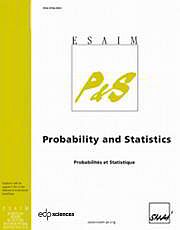Crossref Citations
This article has been cited by the following publications. This list is generated based on data provided by
Crossref.
Tarima, Sergey S.
Slavova, Svetla S.
Fritsch, Travis A.
and
Hall, Laura M.
2007.
Probability estimation when some observations are grouped.
Statistics in Medicine,
Vol. 26,
Issue. 8,
p.
1745.
Tarima, Sergey S.
Vexler, Albert
and
Singh, Siddhartha
2013.
Robust Mean Estimation Under a Possibly Incorrect Log-Normality Assumption.
Communications in Statistics - Simulation and Computation,
Vol. 42,
Issue. 2,
p.
316.
Zenkova, Z. N.
2015.
Censored data treatment using additional information in intelligent medical systems.
Vol. 1688,
Issue. ,
p.
040002.
Dmitriev, Yury G.
and
Koshkin, Gennady M.
2018.
Nonparametric estimators of probability characteristics using unbiased prior conditions.
Statistical Papers,
Vol. 59,
Issue. 4,
p.
1559.
Tarima, Sergey
and
Flournoy, Nancy
2019.
Asymptotic properties of maximum likelihood estimators with sample size recalculation.
Statistical Papers,
Vol. 60,
Issue. 2,
p.
373.
Tarima, Sergey
Tuyishimire, Bonifride
Sparapani, Rodney
Rein, Lisa
and
Meurer, John
2020.
Estimation Combining Unbiased and Possibly Biased Estimators.
Journal of Statistical Theory and Practice,
Vol. 14,
Issue. 2,
Jiang, He
Khan, Muhammad Asif
Li, Zhilong
Ali, Zulfiqar
Ali, Farman
and
Gul, Sajid
2020.
Regional drought assessment using improved precipitation records under auxiliary information.
Tellus A: Dynamic Meteorology and Oceanography,
Vol. 72,
Issue. 1,
p.
1773699.
Ali, Zulfiqar
Hussain, Ijaz
Faisal, Muhammad
Grzegorczyk, Marco Andreas
Almanjahie, Ibrahim M.
Nazeer, Amna
and
Ahmad, Ishfaq
2020.
Characterization of regional hydrological drought using improved precipitation records under multi-auxiliary information.
Theoretical and Applied Climatology,
Vol. 140,
Issue. 1-2,
p.
25.
Tarima, Sergey
and
Zenkova, Zhanna
2022.
Use of Uncertain External Information in Statistical Estimation.
Journal of Engineering Research and Sciences,
Vol. 1,
Issue. 8,
p.
12.
Tarima, Sergey
Patel, Kadam
Sparapani, Rodney
O’Brien, Mallory
Cassidy, Laura
and
Meurer, John
2022.
Mindful Topics on Risk Analysis and Design of Experiments.
p.
78.
Iftikhar, Anum
Shi, Hongbo
Hussain, Saddam
Abbas, Mohsin
Ullah, Kalim
and
Mehmood, Tahir
2022.
Efficient Estimators of Finite Population Mean Based on Extreme Values in Simple Random Sampling.
Mathematical Problems in Engineering,
Vol. 2022,
Issue. ,
p.
1.
Albertus, Mickael
2022.
Asymptotic Z and chi-squared tests with auxiliary information.
Metrika,
Vol. 85,
Issue. 7,
p.
859.
Zenkova, Zhanna N.
Andrievskaya, Anna A.
Yakovlev, Nikita
and
Tarima, Sergey S.
2023.
Transport and Logistics Planning and Optimization.
p.
198.
Zenkova, Zhanna
Tarima, Sergey
Musoni, Wilson
and
Dmitriev, Yuriy
2023.
Statistical Modeling and Simulation for Experimental Design and Machine Learning Applications.
p.
197.
Van Lancker, Kelly
Tarima, Sergey
Bartlett, Jonathan
Bauer, Madeline
Bharani-Dharan, Bharani
Bretz, Frank
Flournoy, Nancy
Michiels, Hege
Olarte Parra, Camila
Rosenberger, James L.
and
Cro, Suzie
2023.
Estimands and their Estimators for Clinical Trials Impacted by the COVID-19 Pandemic: A Report from the NISS Ingram Olkin Forum Series on Unplanned Clinical Trial Disruptions.
Statistics in Biopharmaceutical Research,
Vol. 15,
Issue. 1,
p.
94.
Zenkova, Zhanna
Zenkov, Grigoriy
Musoni, Wilson
and
Tarima, Sergey
2024.
Proceeding of the 7th International Conference on Logistics Operations Management, GOL'24.
Vol. 1104,
Issue. ,
p.
157.
Calderazzo, Silvia
Tarima, Sergey
Reid, Carissa
Flournoy, Nancy
Friede, Tim
Geller, Nancy
Rosenberger, James L
Stallard, Nigel
Ursino, Moreno
Vandemeulebroecke, Marc
Van Lancker, Kelly
and
Zohar, Sarah
2024.
Coping with Information Loss and the Use of Auxiliary Sources of Data: A Report from the NISS Ingram Olkin Forum Series on Unplanned Clinical Trial Disruptions.
Statistics in Biopharmaceutical Research,
Vol. 16,
Issue. 2,
p.
141.
Haq, Abdul
and
Khoo, Michael B. C.
2024.
Enhanced memory-type charts for monitoring the ratio of two normal random variables.
Communications in Statistics - Simulation and Computation,
Vol. 53,
Issue. 6,
p.
2898.
Alghamdi, Abdulaziz S.
and
Alrweili, Hleil
2025.
A Comparative Study of New Ratio-Type Family of Estimators Under Stratified Two-Phase Sampling.
Mathematics,
Vol. 13,
Issue. 3,
p.
327.
Alghamdi, Abdulaziz S.
and
Alrweili, Hleil
2025.
New Class of Estimators for Finite Population Mean Under Stratified Double Phase Sampling with Simulation and Real-Life Application.
Mathematics,
Vol. 13,
Issue. 3,
p.
329.


